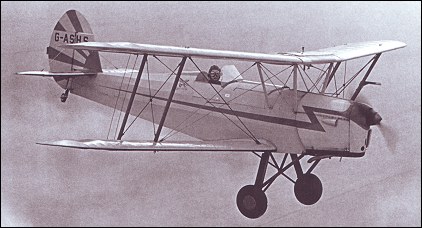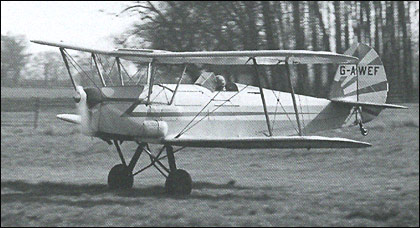|
| Having designed a number of primary training and touring aircraft after World War I, Stampe produced its most notable design, the SV.4, in 1933. This biplane was designed as a trainer or touring aircraft, initially powered by a de Havilland Gipsy Major III engine. However, the first production SV.4A utilized a Renault 4-PO5 engine, which was changed to the Gipsy Major in the improved SV.4B. Pre-World War II production of the
SV.4B was not vast, and it was interrupted by the hostilities, and the 65 built after the war amounted to a total of fewer than 110. Yet the SV.4 was much appreciated in Europe, particularly by the French military, and in the region of 1000 examples were licence-built after World War II by SNCAN in France and Atelier in Algeria.
| MODEL | SV.4B |
| CREW | 1-2 |
| PASSENGERS | 2 |
| ENGINE | 1 x 130hp de Havilland Gipsy I inverted in-line piston engine |
| WEIGHTS |
| Take-off weight | 780 kg | 1720 lb |
| DIMENSIONS |
| Wingspan | 8.40 m | 28 ft 7 in |
| Length | 6.50 m | 21 ft 4 in |
| Height | 2.60 m | 9 ft 6 in |
| PERFORMANCE |
| Max. speed | 200 km/h | 124 mph |
| Ceiling | 5500 m | 18050 ft |
| Range | 600 km | 373 miles |
| Bob Kusterer, e-mail, 01.03.2016 03:10 Hey Steve, did you buy your Franklin Stampe from Charles (Tippy) DiMusis? He's the one who made the original Franklin conversion. We used to fly our Stampes together. reply | | David, e-mail, 15.08.2015 15:18 Got a couple of Qs re the Stampe.
1. The one that I fly has a screw on the tip of all four wings. Are these rigging screws?
2. There are two vertical T handles just forward of the rear seat. Their use?
3. The large knob just to the left of the forward control column. A seat adjust?
Any and all comment welcome.
D reply | | Steven Lyons, e-mail, 01.03.2015 00:34 I still own the stampe that had the Franklin engine. Flew it all over the US. Eventually swapped it out for a Renault. Flew it that way for a few years and it threw a rod. Still restoring it. Also owned a Stampe with a Gipsy Major engine. Reliable but ugly compared to Renault Would like to get in touch with Don Peterson. Anyone have contact? reply | | Bob Kusterer, e-mail, 18.09.2013 00:54 I first flew a Stampe SV-4C at a Belgian aero club; fell in love with it. Ended up buying that one plus another and taking them back to USA. I converted one to 200 HP Ranger power and sold the other to a friend who used a 165 HP Franklin. Both flew really well. A Belgian friend converted his to 180 HP Lyc power; this turned out to be the most popular conversion. Never did like that Renault engine. Had one flight in a Belgian AF SV-4B with a Gipsy; liked that better but my Ranger was the best. reply | |
| | P. G. Cox, e-mail, 05.08.2013 08:58 First time I heard about the Stampe was in the following:
Lt Gen Baron Mike Donnet, the distinguished airman who has died aged 96, made a dramatic escape from his native Belgium in 1941 then served in the RAF throughout the war as a fighter pilot. He later held senior appointments in the Belgian Air Force and in Nato.
After the German invasion of his homeland, Donnet had been held in captivity in Germany for seven months. Then he and his Belgian squadron colleagues were released and returned to Brussels. Donnet and a friend, Leon Divoy, were determined to carry on the fight and made plans to escape to Britain. They and two other patriots discovered an old Stampe SV-4b biplane (similar to a Tiger Moth) in a hangar in the grounds of a heavily guarded German depot. It was intact but needed considerable attention to make it airworthy.
For three months, the four men cycled 20 miles at night to the hangar, replacing missing parts and manufacturing others before refitting them to the aircraft under the noses of the Germans. They also managed to acquire enough fuel for the aircraft by purchasing it on the black market from a Luftwaffe mechanic.
After a couple of false starts (due to the unsuspecting Germans changing the locks to the hangar and the engine failing to start) Donnet and Divoy crept into the hangar on the night of July 4 /5 1941 in their Belgian Air Force uniforms, wheeled out the aircraft, started the engine and took off for England.
With virtually no aircraft instruments, they climbed to 10,000ft and crossed the English Channel, intending to land in Kent. Steering by the Pole Star they eventually crossed the English coast, and, with their meagre supply of fuel running out, landed in a field to discover that they were near Clacton in Essex.
Among those who met them at the local police station was the immigration officer from Harwich. Like Donnet, the vintage aircraft was pressed into RAF service for the duration of the war. reply | | Martin Baker, e-mail, 02.10.2012 22:50 Hi noticed the post on 05.02.2009 about plans. I would like to build a model and wondered if anybody could guide me to some plans for the Stampe. Many thanks
Martin Baker. reply |
| stampe lover, e-mail, 27.03.2012 04:27 the stampe is a tiger eater, i have
considerable time in both aircraft . The tiger while it is iconic , just like the hoover or a cub is no match for a stampe sorry jock if you think the tiger is like a mg LoL more liker an austin 7 I would say reply | | huawuke, 18.06.2011 09:28 A "Moth" has nothing to be compared positively to a Stampe for its outstanding flying caracteristics. reply | | Don Peterson, e-mail, 12.05.2011 18:23 Some aircraft achieve much more than the sum of their parts. The SV4 was built of wire-braced wood with many compromises to allow simplicity of manufacturing and maintenance. Yet the performance is sweet and capable. I have flown many different Stampes, and have observed substantially different flying characteristics from one to the next, perhaps due to the variability in their construction (most often observed in French-built aircraft). Nevertheless, even the worst of them was able to compete in the Advanced aerobatic category as late as 1996, performing all of the maneuvers normally reserved for Pitts, Extras, and other much more modern aircraft. As we like to say, the Stampe is what a Tiger Moth might have been had they gotten it right.
Contrary to the official text associated with this section, the original engine for the French-built Stampes was not a Renault 4PO5, it was a 4Pei, an earlier design without any inverted flight intentions. The 4P01 was a mechanically improved design used on early French-built aircraft. This evolved to the 4P03 with a carburetor able to operate when inverted, and the 4P05 with inverted carburetor and inverted oiling. In practice, the P03 seems to last as long as the P05 even when used in aerobatics, but does not weigh as much. A last-gasp 4Pi06 added fuel-injection and a theoretical increase to 160HP, but the type was never fully developed and had problems in service.
I cannot imagine anyone wanting to build a full-size replica when original aircraft can be had fairly cheaply. At the very least a non-serviceable aircraft can be found and stripped of all its metal fittings, allowing the restorer to concentrate on replacing the wood components. Nevertheless, a complete set of plans are available at a price from a couple of places in the UK, and possibly the Stampe museum in Antwerp.
I expect to my dying day that I will find a smile and a tear for the memories of my time flying Stampes. reply | | Dirk, e-mail, 22.11.2010 23:12 Hello,
Is this SV-4B V61 ? Former G-AZSA ? reply |
| reg Jouhaud, e-mail, 19.11.2010 20:09 Jock if you consider the Stampe as a Jeep, well this is a nice compliment ( I've got a 1944-vintage Willys Jeep and I've been flying Stampes for over half a century)... now I'm afraid as far as aerobatics is concerned the Good old Tiger ( we DO love her) is but a flying barn door... reply | | Dominic Ryland-Jones, e-mail, 15.07.2010 17:30 Hello,
do you happen to know where I can get a 1:72 scale model of a Stampe SV4 (the two seater)? reply | | Leon PESCHE, e-mail, 20.01.2010 22:24 To Mr. Jock Williams,
In EBSH I flew the old TIGER MOTH for 200hrs: Glider Towing. For flying a barrel roll to the right, one needed the force of two hands. The SV4 was the MG, I had one in 1966-69,full of maintenance with the SU carb. You mixed up: The Tiger Moth was the pickuptruck, and the SW4 was the sports car! After St.HUBERT (BELG),[you must be BRITISH, isn't it?] I became ALTP for 33years and flew + 22000hours on FK27-VC8, and B732-4-5. retired with just 20 000 PIC hours. I started flying in 1958, 16 years old on IFJUSAC glider, my instructor was an RAF pilot of WWII.
P.S. the one looking for SV4 plans, may find further info. in St. Hubert in Belgium at the "Vole a Voile" airfield. CNVVSH. EBSH reply | | fabrice, e-mail, 17.05.2009 16:02 Hello
I'm looking for the plan of this aircraft (for electric prop).
Is it possible to have it
Best regards
FGZ reply | |
| | charles, e-mail, 15.05.2009 16:46 It seems obvious that "Joke" williams forgot to fasten his seat belt when flying his Tiger Moth during an inverted flight and that his head hit the ground...
A "Moth" has nothing to be compared positively to a Stampe for its outstanding flying caracteristics.
He has certainly never fly the one and the other.
Sorry, joker ! reply | | Jock Williams, e-mail, 16.04.2009 09:15 Beacuse I was experienced in the Tiger Moth I was called upon to check out a number of RCAF pilots who purchased surplus Stampes from the Belgian Air Force in the early 1970s.
The Stampe had the same engine as the Tiger and the same basic configuration -but had an inverted fuel system and ailerons on both upper and lower wings instead of just on the lower as in the Tiger.
Accordingly the Stampe did more impressive aerobatics -but I just never learned to love it as much as the Tiger Moth.
THe Stampe was a Jeep while the Tiger was an MG. Those who know the differnce will understand -and those who do not -will never understand!
Jock Williams Yogi 13 reply | | Luis M. Moreno, e-mail, 01.03.2009 20:39 El Stampe SV-4 es uno de mis mejores recuerdos como piloto. Deliciosamente magnífico volarlo. reply | | Justin, e-mail, 05.02.2009 16:40 Hi i am looking to build a full size stampe sv4 if anyone knows where i can get a set of plans please let me know thanx reply |
|
Do you have any comments?
|
| 
All the World's Rotorcraft |







 Dirk
Dirk
20
reply